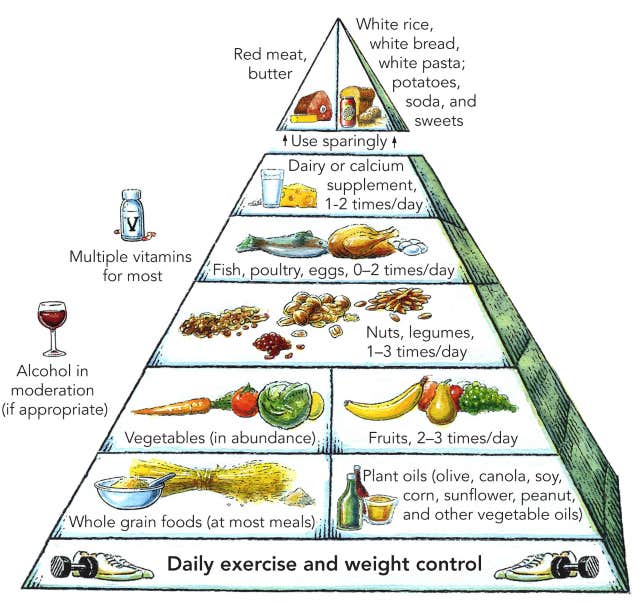Why The Food Pyramid Was Never Meant To Keep You Healthy
We were set up for failure.
 Muenz, Marilyn Nieves / Getty Images via Canva
Muenz, Marilyn Nieves / Getty Images via Canva Who can forget learning about how to have a healthy diet from the food pyramid? The colorful triangular shape gave us dietary guidelines to live by for a long and healthy life.
The first food pyramid was created in Sweden in the 1970s. There were street protests about the high price of foods and the government created a committee to determine if a healthy meal could be put together at an affordable price.
Dr. Luise Light was the nutritional expert who created the food guide pyramid we are all familiar with. It was introduced to the public in 1992 by the United States Department of Agriculture (USDA), and consisted of six blocks, stacked from largest to smallest.
What is the food pyramid?
The food pyramid was a visual representation of the food groups, showcasing dietary advice on what people should be consuming for optimal health.
The foods at the base of the pyramid were refined grains such as rice, bread, and pasta, and it was suggested that people consume 6-11 servings daily.
Then came servings of fruits and vegetables at 2-4 servings and 3-5 servings, respectively.
Next, people were advised to eat 2-3 servings of dairy products, then 2-3 servings of proteins like red meats, eggs, beans, and nuts.
Fats and oils topped the pyramid, rounding out a supposed balanced diet.
The food pyramid was based on the premise that people needed to get the most nutritional value they could at the lowest cost. So, the entire diet was made up of a huge amount of carbohydrates.
But with more understanding about the effect of carbs on body weight and health, and the benefits of healthy fats, it seems the food industry may have been following misleading advice.
Is the food pyramid wrong?
We now know that fat foods are not necessarily "bad" for you. As a matter of fact, foods labeled "low-fat" have been known to create more problems than they prevent.
Consumers thought they were doing the right thing when they replaced high fat foods with processed junk food that was touted as low-fat.
Those low-fat, fat-free, and reduced fat items often contained additives like sugar, salt and chemical filler, which was detrimental to our health. Some of the side effects were chronic disease, weight gain, and risks to your heart health.
In addition, because of the ill-advised overconsumption of carbohydrates, many people started developing type 2 diabetes. This happened because their bodies were either unable to produce enough insulin or unable to process the excess insulin it creates.
Registered dietitian Susan Bowerman pointed out the fact that the “grain” group at the base of the was influenced by lobbyists in the grain industry.
Many believe that consumers were deceived by the food industry and big corporations.
The results from determining exactly what a healthy diet looked like would not maximize profits for food corporations, so it was changed.
The recommended 5-9 servings of fruit and veggies was reduced to 2-3.
Cereal companies were behind adjusting the 5 servings of grains to up to 11.
As for dairy products, there was no recommendation, but it, too, was added to benefit the dairy industry.
Corporations tricked consumers into thinking carbs were a separate food group from fruits and vegetables.
Luise Light, MS, who was part of the inception of the pyramid agreed, stating, "The type of grains suggested by the pyramid were also a problem. The pyramid didn’t emphasize whole grains and so in some ways encouraged the intake of refined grains.”
Another problem with the food pyramid was the absence of any guidance on portion size for each food group. People likely overestimated what a correct portion of food looked like and over-ate.
Apparently, the original food pyramid was accompanied by a booklet that explained how to correctly measure a portion size. Most people were unaware that such a pamphlet even existed.
There have been several studies over the years, such as the Women’s Health Initiative and the Nurses’ Health Study, that found that overall consumption of fat did not lead to coronary heart disease. Instead, it was the type of fat that was a contributing factor.
The food pyramid has gone through several iterations since it was created. In the latest iteration, you can see that daily exercise has been added as the foundation, while red meats and processed carbohydrates are minimized.
 Photo: EAT, DRINK, AND BE HEALTHY by Walter C. Willett, M.D. via Wikimedia Commons
Photo: EAT, DRINK, AND BE HEALTHY by Walter C. Willett, M.D. via Wikimedia Commons
Vegetables are now independent of fruit and can be eaten in abundance. Whole grains and plant oils are specified over the generalizations that previously existed.
Surprisingly, the new pyramid even allows for multi-vitamins and alcohol in moderation for those who can have them.
The decision to make changes came as a result of the recognition that the original pyramid had not resulted in a decrease in heart disease, obesity, or diabetes.
In 2011, the USDA, with First Lady Michelle Obama at the helm, changed the dietary guidelines to the MyPlate model. The idea was to encourage people to think about building a balanced and healthy plate at meal time.
The good news is that despite all of the things that have gone wrong, with a bigger focus on the incorporation of fruits and vegetables, our diets are moving in the right direction.
NyRee Ausler is a writer from Seattle, Washington, and author of seven books. She covers lifestyle and entertainment and news, as well as navigating the workplace and social issues.

